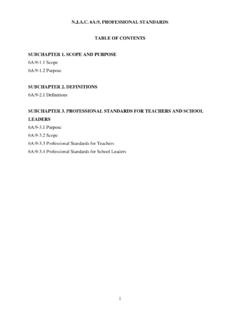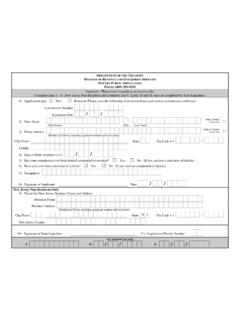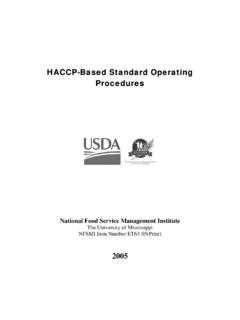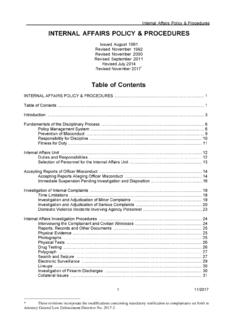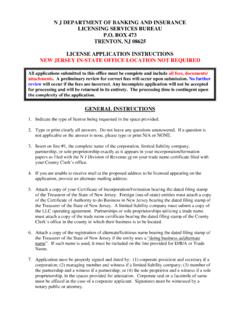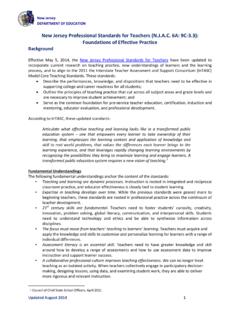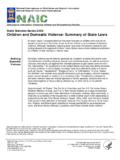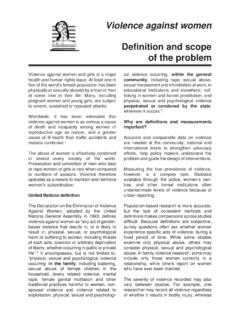Transcription of DOMESTIC VIOLENCE Guidelines on Police Response …
1 DOMESTIC VIOLENCEG uidelines on Police Response Procedures in DOMESTIC VIOLENCE Cases Issued October 1991 Revised November 1994 Introduction. These general Guidelines consolidate the Police Response procedures for domesticviolence cases, including abuse and neglect of the elderly and disabled, based on State law, CourtRules, and the DOMESTIC VIOLENCE Procedures Manual which was jointly prepared by the NewJersey Supreme Court and the Attorney General through the Division of Criminal Justice. I. Definitions. A. DOMESTIC VIOLENCE means the occurrence of one or more of the following criminal offensesupon a person protected under the Prevention of DOMESTIC VIOLENCE Act of 1990: Homicide 2C:11-1 Assault 2C:12-1 Terroristic threats 2C:12-3 Kidnapping 2C:13-1 Criminal restraint 2C:13-2 False imprisonment 2C:13-3 Sexual assault 2C:14-2 Criminal sexual contact.
2 2C:14-3 Lewdness 2C:14-4 Criminal mischief. 2C:17-3 Burglary 2C:18-2 Criminal trespass 2C:18-3 Harassment 2C:33-4 Stalking 2C:12-10 B. Victim of DOMESTIC VIOLENCE means a person protected by the DOMESTIC VIOLENCE act andincludes any person: 1. who is 18 years of age or older, or 2. who is an emancipated minor, and who has been subjected to DOMESTIC VIOLENCE by: a. spouse b. former spouse c. any other person who is a present or former household member, OR 3. who, regardless of age, has been subjected to DOMESTIC VIOLENCE by a person: a. with whom the victim has a child in common, or b. with whom the victim anticipates having a child in common, if one of the parties is pregnant,or 4. who, regardless of age, has been subjected to DOMESTIC VIOLENCE by a person with whom thevictim has had a dating relationship.
3 A. A victim may be below the age of 18. b. The DOMESTIC VIOLENCE assailant must be over the age of 18 or emancipated at the time of theoffense. See Paragraph C3 below for criteria for determining whether a person is emancipated. C. Note: 1. The Prevention of DOMESTIC VIOLENCE Act does not define a victim of DOMESTIC VIOLENCE byage, physical or psychological condition or sex. 2. AN UNEMANCIPATED MINOR WHO COMMITS AN ACT OF DOMESTIC VIOLENCEMAY NOT BE PROSECUTED AS A DOMESTIC VIOLENCE DEFENDANT BUT CAN BEPROSECUTED UNDER THE JUVENILE DELINQUENCY LAWS. THE ENTRY OF PRE-OR POST-DISPOSITIONAL RESTRAINTS CAN ALSO BE CONSIDERED. 3. A minor is considered emancipated from his or her parents when the minor: a. has been married; b. has entered military service; c. has a child or is pregnant; or d. has been previously declared by a court or an administrative agency to be emancipated.
4 II. Mandatory Arrest. A Police officer must arrest and take into custody a DOMESTIC violencesuspect and must sign the criminal complaint against that person if A. The victim exhibits signs of injury caused by an act of DOMESTIC VIOLENCE . :25-21a(1). 1. The word, "exhibits," is to be liberally construed to mean any indication that a victim hassuffered bodily injury, which shall include physical pain or any impairment of physical cause to arrest also may be established when the Police officer observes manifestationsof an internal injury suffered by the victim. 2. Where the victim exhibits no visible sign of injury, but states that an injury has occurred, theofficer should consider other relevant factors in determining whether there is probable cause tomake an arrest. 3. In determining which party in a DOMESTIC VIOLENCE incident is the victim where both partiesexhibit signs of injury, the officer should consider: a.
5 The comparative extent of injuries suffered; b. the history of DOMESTIC VIOLENCE between the parties, if any, or c. other relevant factors. 4. Police shall follow standard procedures in rendering or summoning emergency treatment ofthe victim, if required. B. There is probable cause to believe that the terms of a no contact court order have beenviolated. If the victim does not have a copy of the court order, the officer may verify theexistence of an order with the appropriate law enforcement agency. C. A warrant is in effect. D. There is probable cause to believe that a weapon as defined in 2C:39-1r has beeninvolved in the commission of an act of DOMESTIC VIOLENCE . III. Discretionary Arrest. A Police officer may arrest a person or may sign a criminal complaintagainst that person, or may do both, where there is probable cause to believe that an act ofdomestic VIOLENCE has been committed but none of the conditions in Section II.
6 Above applies. IV. Seizure of Weapons. A. Seizure of a Weapon for Safekeeping. A Police officer who has probable cause to believe that an act of DOMESTIC VIOLENCE has beencommitted may: 1. Question all persons present to determine whether there are weapons, as defined in :39-1r, on the premises. 2. If an officer sees or learns that a weapon is present within the premises of a DOMESTIC violenceincident and reasonably believes that the weapon would expose the victim to a risk of seriousbodily injury, the officer should attempt to gain possession of the weapon. 3. If the weapon is in plain view, the officer should seize the weapon. 4. If the weapon is not in plain view but is located within the premises jointly possessed by boththe DOMESTIC VIOLENCE assailant and the DOMESTIC VIOLENCE victim, the officer should obtain theconsent, preferably in writing, of the DOMESTIC VIOLENCE victim to search for and to seize theweapon.
7 5. If the weapon is not located within the premises jointly possessed by the DOMESTIC violencevictim and assailant but is located upon other premises, the officer should attempt to obtainpossession of the weapon from the possessor of the weapon, either the DOMESTIC violenceassailant or a third party, by a voluntary surrender of the weapon. 6. If the DOMESTIC VIOLENCE assailant or the possessor of the weapon refuses to surrender theweapon or to allow the officer to enter the premises to search for the named weapon, the officershould obtain a DOMESTIC VIOLENCE Warrant for the Search and Seizure of Weapons. [SeeAppendix 13] B. Seizure of a Weapon Pursuant to Court Order. 1. If a DOMESTIC VIOLENCE victim obtains a court order directing that the DOMESTIC violenceassailant surrender a named weapon, the officer should demand that the person surrender thenamed weapon.
8 2. If the DOMESTIC VIOLENCE assailant or the possessor of the weapon refuses to surrender theweapon, the officer should a. inform the person that the court order authorizes a search and seizure of the premises for thenamed weapon, and b. arrest the person, if the person refuses to surrender the named weapon, for failing to complywith the court order, 2C:29-9, and c. conduct a search of the named premises for the named weapon. C. The officer must append an inventory of seized weapons to the DOMESTIC VIOLENCE offensereport. D. Weapons seized by a Police officer must be promptly delivered to the county prosecutor alongwith a copy of the DOMESTIC VIOLENCE offense report and, where applicable, the DOMESTIC violencecomplaint and temporary restraining order. V. DOMESTIC VIOLENCE Complaint. A. Notice.
9 When a Police officer responds to a call of a DOMESTIC VIOLENCE incident, the officermust give and explain to the victim the DOMESTIC VIOLENCE notice of rights which advises thevictim of available court action. 2C:25-23. The victim may file 1. A DOMESTIC VIOLENCE complaint alleging the defendant committed an act of DOMESTIC violenceand asking for court assistance to prevent its recurrence by asking for a temporary restrainingcourt order (TRO) or other relief; 2. A criminal complaint alleging the defendant committed a criminal act. See Section Arrest above when a Police officer must sign the criminal complaint; 3. Both of the above. B. Jurisdiction for filing DOMESTIC VIOLENCE complaint by the victim. 1. During regular court hours, a. The victim should be transported or directed to the Family Part of the Superior Court.
10 B. Where transportation of the victim to the Superior Court is not feasible, the officer shouldtelephone the designated court by telephone for an emergent temporary restraining order inaccordance with established procedure. 2. On weekends, holidays and other times when the court is closed. a. The victim may file the DOMESTIC VIOLENCE complaint before a municipal court judgespecifically assigned to accept these complaints. 3. The victim may file a DOMESTIC VIOLENCE complaint: a. where the alleged act of DOMESTIC VIOLENCE occurred. b. where the defendant resides, or c. where the victim resides or is sheltered. C. Jurisdiction for filing criminal complaint by the victim in connection with filing domesticviolence complaint. 1. A criminal complaint may be filed against the defendant in locations indicated in Paragraph B3above.
